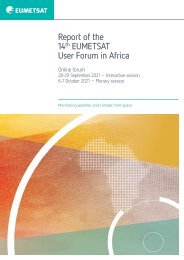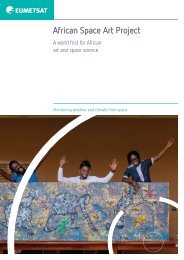EUMETSAT Annual Report 2021
Create successful ePaper yourself
Turn your PDF publications into a flip-book with our unique Google optimized e-Paper software.
<strong>EUMETSAT</strong> ANNUAL REPORT <strong>2021</strong><br />
MANAGEMENT AND ADMINISTRATION<br />
COMMUNICATION AND OUTREACH<br />
Due to pandemic restrictions, large events in <strong>2021</strong> could not take<br />
place fully in person.<br />
<strong>EUMETSAT</strong>, the World Meteorological Organization and the<br />
European Centre for Medium-Range Weather Forecasts (ECMWF)<br />
held an online workshop in February for member state weather<br />
services’ communication teams. The workshop was a useful<br />
platform for sharing experiences and ideas for communicating<br />
about weather and climate issues in Europe.<br />
Charging stations for electric vehicles are available on <strong>EUMETSAT</strong> premises<br />
SUSTAINABLE <strong>EUMETSAT</strong><br />
<strong>EUMETSAT</strong> is committed to sustainability and to taking measures<br />
to limit its carbon footprint, for example, by installing energy<br />
efficient lighting, scrapping the use of non-recyclable coffee cups<br />
and providing chargers for electric vehicles.<br />
The Technical Infrastructure Building again received the highest<br />
level Certified Energy Efficiency Data Centre Award (CEEDA) in<br />
<strong>2021</strong>. The certification recognises the building’s energy efficiency.<br />
<strong>EUMETSAT</strong> already receives 100% of its electricity supply from<br />
renewable sources. The Technical Infrastructure Building is the<br />
largest consumer of energy at <strong>EUMETSAT</strong>, accounting for 62% of<br />
the campus’s entire energy use. Ensuring it is run as efficiently as<br />
possible provides value for our member states.<br />
In a first, the annual <strong>EUMETSAT</strong> Meteorological Satellite<br />
Conference, which took place on 20-24 September, was held<br />
fully online. This posed challenges for the organising team, as<br />
this type of conference required a different type of programme<br />
and technology to be effective. The conference attracted 700<br />
participants, about 40% more than usual.<br />
As part of activities to promote the Copernicus Programme and<br />
WEkEO, <strong>EUMETSAT</strong> launched a new massive open online course<br />
(MOOC) on the theme of artificial intelligence and Earth monitoring<br />
in October. The course was hosted on the FutureLearn MOOC<br />
platform. It included video interviews with more than 40 experts,<br />
text, animations, and a series of Jupyter notebooks to show<br />
people how to work with Copernicus data and machine learning<br />
techniques on the WEkEO platform. The course attracted nearly<br />
10,000 participants and has led to an increase of more than 5,000<br />
new users for WEkEO. The MOOC was a joint project involving<br />
<strong>EUMETSAT</strong>, the ECMWF, Mercator Ocean International and the<br />
European Environment Agency.<br />
54









